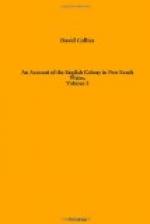Two men were tried for having killed a native youth, well known in the settlement*; but it appearing to the court that he had been accidentally shot, they were acquitted. The natives certainly behaved ill, and often provoked the death which they met with; but there was not any necessity for wantonly destroying them, a circumstance which it was feared had but too often occurred. On the acquittal of these prisoners, they were assured by the governor, that he was determined to make an example of the first person who should be convicted of having wantonly taken the life of a native.
[* By the name of Tom Rowley (after one of the officers of the regiment). He had accompanied Mr. Raven, in the Britannia, to Bengal, in the year 1795.]
Another prisoner, John Morris, was tried for the murder of Charles Martin, by violently kicking and beating him, so that he died the following day. He was found guilty of manslaughter, and sentenced to be burned in the hand and imprisoned for 12 months.
One man was found guilty of uttering a bill knowing it to be forged, and adjudged to suffer death; and two others, for theft, were ordered to be transported to Norfolk Island, one for the term of his life, and another for seven years.
It appearing on one of these trials, that three of the witnesses had manifestly and wilfully committed the crime of perjury, they were brought to trial; and, being found guilty, were sentenced to stand in the pillory; to which, as an additional punishment, their ears were to be nailed. Their sentence was put in execution before the public provision store, when the mob, either to display their aversion to the crime, or, what might be more probable, to catch at any thing that wore the form of amusement, pelted them with rotten eggs and dirt.
These people were three of the worst characters in the colony, Luke Normington, John Colley, and William Osborne. It amounted nearly to a mockery and profanation of religion to administer an oath to such hardened and unprincipled wretches; yet their testimony could not be refused when called for by a prisoner who was standing under the weight of a capital charge; but of the credibility of such testimony it was always in the breast of the court to judge.
On this occasion the governor deemed it advisable to explain, in public orders, the nature of this dreadful offence, an offence so certainly ruinous both to their temporal and eternal welfare. He pointed out to them, that, as every man who stood convicted of this dangerous breach of the law was thereby rendered infamous ever after, no one who had a character to lose (alas! how few were there who would feel themselves affected by this observation) would associate with such criminals, lest he should endanger his own reputation, and be considered as a voluntary approver and partaker in the infamy.
It may be some relief to turn from the contemplation of such iniquity, though it should be only to the transactions of savages, differing from these wretches but in complexion.




